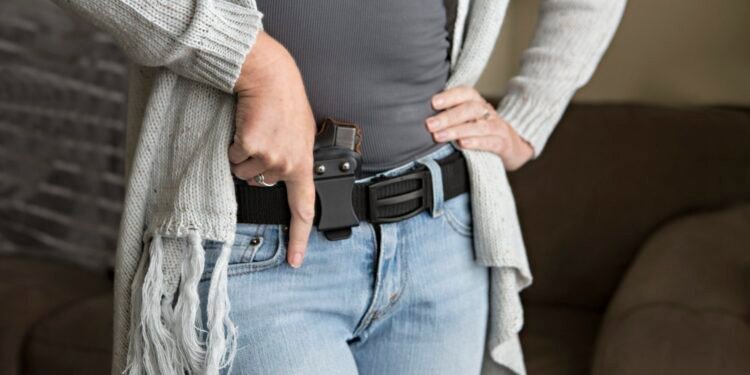Last Updated on October 18, 2023 by Flavia Calina
There’s a lot to consider when dressing for concealed carry. Choosing fabrics that conceal well to ensure your cover garment doesn’t prevent you from quickly accessing your weapon. Many people focus on ensuring the gun is invisible, but this shouldn’t be the main consideration. The ability to clear the cover garment and draw should be your priority.
Pants
Many concealed carriers don’t consider pants a major factor in their CCW clothing. They may cram a pistol into standard jeans and then drop a shirt one size too big over it. All while thinking they’re covering their gun with their clothing.
The problem with this approach is that the fabric or fit of a shirt can hide the outline of a handgun. But it will also create hotspots that are difficult to clear when it’s time to draw your firearm. A better option is to select relaxed-fit pants that are a waist size larger than you typically wear and use a holster designed for that specific pant style.
Regardless of your pants, they should have belt loops that accommodate your gun belt. Narrow-leg jeans (and some pants designed for women) lack these loops and are unsuitable for carrying IWB. They can be worn with a pocket-free holster. But you will need more utility, speed, and retention of a properly fitted IWB rig.
Shirts
A concealed carry shirt may seem simple. But finding one that provides the accessibility you need without compromising comfort can be challenging. Luckily, options are now available to help you find a concealable shirt that’s both comfortable and ready for action.
For example, a t-shirt designed with ambidextrous hidden pockets is a great way to make it easy to access your weapon. Whether left or right-handed. The pockets also allow you to store other useful items such as multi-tools, extra weapon magazines, emergency equipment, or a smartphone.
Another consideration is the fabric and style of a shirt. Light. Drapey fabrics can cling to the gun and cause printing. While structured shirts with larger hems can reduce printing by eliminating swaths of fabric that could catch on your firearm. Aim for a shirt that fits normally around the shoulders and neck before flaring out toward the hem to provide more room for an IWB holster.
Jackets
Many jackets feature snap buttons rather than traditional ones for a more discreet look. These are easy to access and, with practice, can be done one-handed. This makes them ideal for concealed carry.
Jackets should also allow for the carrying of larger sidearms, and they should have plenty of interior pockets. The gun pocket should be large enough to accommodate a full-sized firearm and be well-positioned to be easily accessible without having to clear the garment.
Those who must dress up for work should consider jackets designed to conceal a handgun. These jackets can look like regular coats and help people to conceal their weapons for a professional appearance at events, in public places, and on the job. These jackets are also ideal for service members and police officers who must dress up while on patrol or attending high-end events. The printing issue of these jackets is not as much of a concern as it may be in other types of clothes. Though, as the gun’s bulge and outline usually blend in with other body contours.
Shorts
Regarding shorts, the guiding principle is whatever covers your weapon best and works with your holster. Some people wear a t-shirt under an IWB holster, while others prefer a long, untucked shirt, such as a flannel or button-up.
Both options look great with neutral shoes and can be dressed up or down as needed. For instance, a pair of khaki shorts with a casual button-down or a polo shirt can give a professional appearance while still providing cover.
Another factor to consider is gun printing. A lot of concealed carry clothing will cling to your firearm, causing the outline or bulge to be visible through your garment. However, purpose-built concealed carry pants from companies are designed with this in mind. Reducing or eliminating printing. They also feature a waistband that’s a few inches bigger than normal to reduce clinging and hot spots. Read more exciting articles on Today World Info









